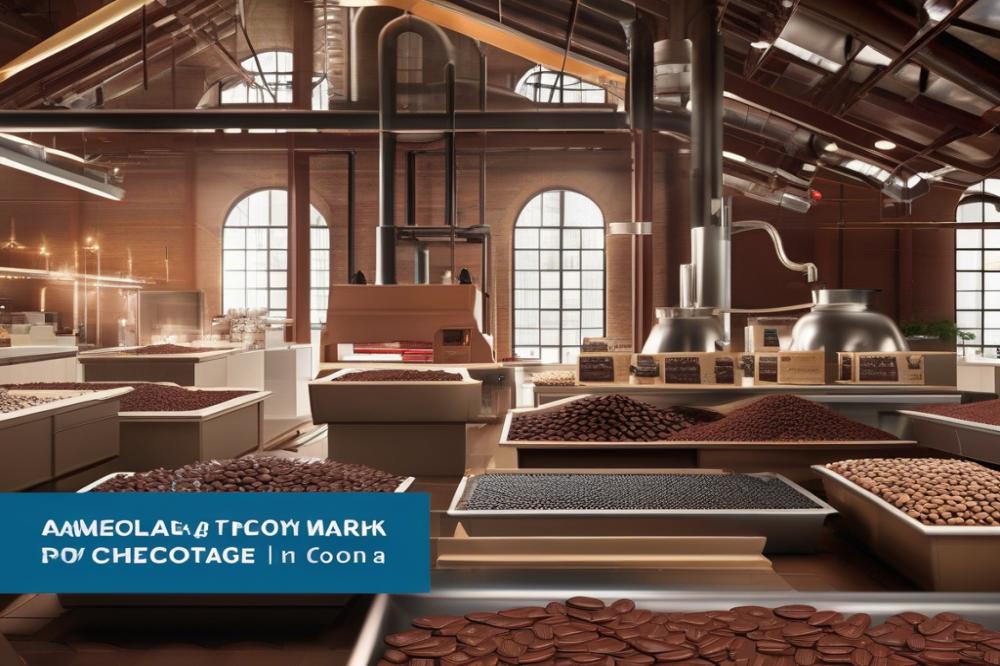Overview of chocolate economics
Chocolate holds a special place in American culture. Its popularity continues to grow, influencing various aspects of our economy. The chocolate industry presents an interesting mix of opportunities and challenges. Understanding this market can shed light on broader economic themes, especially when looking at costs and profits.
The cost of chocolate production involves many factors. Farmers grow cocoa beans in different countries, which affects pricing based on weather conditions and supply chain issues. Fluctuations in cocoa prices impact everything from big brands to small artisanal producers. As cocoa costs rise, chocolate manufacturers must make tough decisions on pricing, often passing some expenses onto consumers.
Recent chocolate sales statistics indicate a surge in demand, particularly for premium products. Artisan chocolate, with its handcrafted appeal, is becoming more mainstream. Many consumers are craving unique flavors and quality ingredients. Alongside this, the younger generation is increasingly demanding sustainable chocolate sourcing. They want assurance that their beloved treat is produced ethically.
Seasonal demand also plays a role in chocolate profits. Events like Valentine’s Day and Halloween often lead to significant sales spikes. Companies prepare well in advance to meet consumer expectations during these peak periods. Keeping an eye on chocolate market trends allows businesses to strategize effectively.
Consumer preferences are shifting toward healthier options, which is reshaping the confectionery market. Dark chocolate, for example, is seen as a better choice compared to its milk counterpart. This change in taste influences product development and marketing strategies. Consequently, understanding chocolate economics helps stakeholders make informed decisions in a competitive marketplace.
Understanding the Costs of Chocolate Production

When examining the economics of chocolate making, the cost of chocolate production starts with raw materials. Cocoa prices play a crucial role in this process. Fluctuations in cocoa prices can significantly impact profit margins for chocolate producers. For instance, recent trends show price surges that challenge smaller producers. They often face different pricing structures than larger companies.
Aside from cocoa, production expenses encompass various other components. Labor costs contribute significantly to overall expenses. Skilled workers are necessary for both mass production and artisan chocolate. Equipment also bears considerable expenses. Quality machines aid in efficient production, but they require substantial initial investments. Facilities need proper maintenance as well. This ensures that the production environment meets safety and quality standards.
In recent years, the impact of sustainable chocolate sourcing has become more pronounced. Consumers increasingly demand ethically sourced chocolate. This shift can lead to higher costs for companies. Sustainable practices may involve paying farmers more for their cocoa. These initiatives support environmental conservation but affect the price tag on finished products.
Artisan chocolate presents another layer of complexity in production costs. The craft of making artisan chocolate often requires more time and precision. Ingredients used are often of higher quality, which raises expenses. Comparatively, traditional chocolate production may prioritize efficiency over artistry. This difference results in various pricing strategies. Moreover, businesses must navigate chocolate sales statistics, constantly adjusting to consumer preferences. Understanding seasonal demand also plays a significant role in managing production cycles.
The chocolate supply chain remains intricate and sensitive to global changes. Competing in the confectionery market demands agility. Companies must respond to trends while keeping their cost structures viable. The dynamics of the chocolate industry profits are ever-evolving, influenced by everything from raw materials to consumer choices.
Chocolate Industry Profits and Market Dynamics

The chocolate industry in the USA is a complex web of costs, profits, and consumer trends. Profit margins vary greatly across different segments. Large companies often enjoy economies of scale that allow for reduced production costs. Small businesses, like artisan chocolate makers, sometimes struggle to compete due to their higher costs.
Cost of chocolate production is heavily influenced by cocoa prices. When these prices fluctuate, they can dramatically affect profits. If cocoa becomes expensive, manufacturers may have to increase prices, which could deter sales. This situation highlights the fragility of profit margins in the confectionery market.
Factors Affecting Profit Margins
Several factors play into determining profit potential. The chocolate supply chain is a critical component. It encompasses everything from sourcing cocoa to distributing finished products. Efficient supply chain management can significantly enhance profitability by minimizing waste and delays.
Competition in the market is fierce. Larger brands often dominate due to their established presence. They can use pricing strategies, like temporary discounts, to attract more customers. In contrast, smaller companies may focus on niche markets, offering unique flavors or sustainable chocolate sourcing to set themselves apart.
Market Competition and Pricing Strategies
Pricing strategies are essential to maintaining market share. Companies must carefully analyze consumer preferences and adjust their offerings accordingly. Seasonal demand, such as during holidays, can lead to higher sales volumes. This spikes, therefore, create opportunities for profit during certain times of the year.
Recent chocolate sales statistics reveal an interesting trend. Consumers are increasingly interested in premium products. This shift indicates a growing appreciation for quality over quantity. As a result, both big and small players in the market are adapting their strategies. They are focusing more on health-conscious options and ethical sourcing practices.
Trends in Chocolate Sales Statistics
Insights from market data suggest that the future of chocolate is not just sweet. The desire for transparency in sourcing practices is changing industry dynamics. Many consumers now seek out brands committed to sustainability. These changes can have lasting implications for overall profitability in the sector.
Understanding these market dynamics is crucial for anyone looking to invest. The chocolate industry is evolving, shaped by both competition and consumer demand. Manufacturers must remain vigilant, ensuring that they adapt to these trends to maximize their potential profits.
The Chocolate Supply Chain
The chocolate supply chain is a complex network that connects cocoa farmers to retailers. Farmers cultivate cocoa beans primarily in tropical regions, such as West Africa and South America. After harvesting, beans are fermented, dried, and shipped to manufacturers. These companies process the cocoa into various products like cocoa powder, chocolate liquor, and butter.
Global cocoa production faces numerous challenges. Fluctuating cocoa prices can impact farmer income and production levels. Climate change affects crop yields due to extreme weather conditions. Pests and diseases also threaten cocoa farms, leading to reduced production. These factors cause instability in the market and can drive up the cost of chocolate production for manufacturers.
Logistics and Distribution
Logistics play a significant role in managing chocolate flow from farms to store shelves. Transportation involves various stakeholders, from shipping companies to local distributors. Efficient logistics systems can decrease costs and enhance profits for businesses in the confectionery market. In contrast, delays or disruptions can lead to increased costs, affecting chocolate sales statistics.
Seasonal demand influences distribution strategies in the chocolate market. During holidays like Valentine’s Day and Halloween, chocolate sales surge. This seasonal spike requires manufacturers to stock adequately for increased consumer preferences. Retailers depend on reliable logistics to meet this demand, ensuring products reach customers on time.
Quality and Sustainability Challenges
Maintaining quality is crucial in the chocolate supply chain. Manufacturers must uphold high standards to satisfy customers. They also face the challenge of sourcing sustainable chocolate. More consumers are favoring brands that utilize ethical practices in sourcing. To stand out, companies must invest in transparency and sustainable chocolate sourcing practices.
Quality issues can arise during transportation, storage, or processing. Temperature and humidity can affect the chocolate’s texture and flavor profile. Small-scale artisans often struggle to keep up with these standards while competing with larger brands. For them, finding a balance between quality and cost is critical to success.
The chocolate industry profits depend greatly on the management of these supply chain elements. If producers cannot maintain quality while controlling costs, profit margins shrink. Likewise, consumer demand for artisan chocolate continues to rise, pushing brands to adapt quickly. Ultimately, each link in the chocolate supply chain needs to work cohesively to create a successful end product.
Consumer Preferences and Market Trends
Changing consumer preferences are reshaping the landscape of chocolate products. Today, more people are leaning towards healthier options. Items like dark chocolate and those with less sugar are gaining traction. Shoppers are paying attention to the ingredients in their confections. This shift reflects a broader focus on well-being and quality.
The rise of artisan chocolate has created a buzz in the market. Many consumers are now searching for unique flavors and handcrafted quality. Artisan chocolatiers often emphasize the origin of their cocoa. They highlight sustainable chocolate sourcing, which appeals to eco-conscious buyers. This trend is driving higher prices, impacting the overall cost of chocolate production.
Seasonal demand patterns greatly influence chocolate sales statistics. Events like Valentine’s Day and Halloween see sharp increases in purchases. Marketing strategies during these periods capitalize on emotions and traditions. Manufacturers often prepare for these spikes well in advance. Understanding when consumers are most likely to buy is crucial for business planning.
The confectionery market is experiencing several current trends. One notable shift is the preference for plant-based chocolates. These options are becoming more mainstream as people look for alternatives. Additionally, interest in premium chocolate bars is rising. This trend can lead to higher chocolate industry profits for those willing to invest in quality.
Cocoa prices remain volatile, which affects many aspects of the chocolate supply chain. Fluctuations can change production costs overnight. Companies need to navigate these changes carefully to maintain their profit margins. Observing how consumer preferences evolve will be essential for future profitability. Anticipating the market’s next move can provide a competitive edge.
Final Thoughts on the Economics of Chocolate Making
The world of chocolate making in the USA is a complex blend of costs, profits, and market trends. As we look back, we see that producers face many challenges. The cost of chocolate production hinges on several factors, including raw materials, labor, and supply chain dynamics. Fluctuations in cocoa prices significantly affect the overall affordability of chocolate. Environmental concerns also play a role in shaping the industry’s future.
Profit margins vary widely. While premium brands may enjoy higher chocolate industry profits, smaller or artisanal makers often struggle to keep up. Consumers increasingly value sustainability. This awareness could sway spending habits and influence pricing strategies. Balancing the need for profitability with the push for eco-friendly practices remains a significant hurdle.
Future prospects seem promising but filled with competition. As new players enter the market, established brands must innovate to stay relevant. Trends such as bean-to-bar production and unique flavor profiles attract more customers. Additionally, online sales are reshaping how chocolate is marketed and sold. These changes create opportunities for growth while maintaining quality.
In summary, the landscape of chocolate making in the USA requires careful navigation. Businesses must remain aware of costs while seeking ways to resonate with consumers. Sustainability, quality, and creativity could redefine success in this ever-evolving market. With the right balance, the industry can thrive in the coming years.



